A SOUTH COAST ADVENTURE
Jamie Crawford was recently invited aboard a Wirrina-based charter boat to explore the untouched waters south of KI. He certainly wasn’t disappointed!
Many of our readers would have seen Ned McHenry in these pages before, or watched his weekly fishing report on Channel 7, “Catch of the Day”. Hailing from Geelong in Victoria, Ned was drafted by the Adelaide Crows in 2018 and played six seasons with the club. Aside from footy, his passion is fishing, and he is regularly seen travelling around the state chasing everything from barrels in the South East to samsons in the west.
His regular stomping grounds are out from Victor Harbor and Cape Jervis, where he spends plenty of days on the water in his beloved Northbank. Overnight sojourns along the north coast of KI are one of Ned’s favourites, and he seems quite sold on the lifestyle and fishing options we have here in SA.
His new endeavor is a lifestyle TV show on channel 7, Reel Talk, which encompasses travel and fishing destinations around our state. The south coast of KI had been a destination Ned was keen to visit and film, but given the distances involved and logistics required to access these remote waters, it’s a fair task for a trailer boat – even a well-equipped and capable one. Hence a larger vessel would need to be employed to tackle this coast in comfort and safety.
Fish Stalker II, a 50ft Westcoaster based out of Wirrina Cove on the Southern Fleurieu Peninsula, offers the perfect platform for accessing the offshore waters along the south coast of Kangaroo Island. Operated by Southern Fishing Charters and skippered by Jarrod Glaister, Fish Stalker II is a very comfortable and seaworthy vessel with the legendary Westcoaster status. The vessel is purpose built for our southern waters and is kitted out with some of the best electronics – the perfect platform for spending multiple nights at sea.
Ned booked Fish Stalker II for a two night /three day trip departing Wirrina Cove with the intention of fishing the blue water reefs along the south coast of KI. Skipper Jarrod offers long range trips to these waters on request, and knows the area exceptionally well. Ned extended the invite to myself, and having never fished offshore from KI’s south coast, I was keen for the adventure. Also along on the trip was Jamie Rymell, manager of Tackle World Adelaide Metro, and his son Ben, plus Ned’s cameraman and producer. With the plan in place, we all had fingers crossed that the weather was going to play the game.
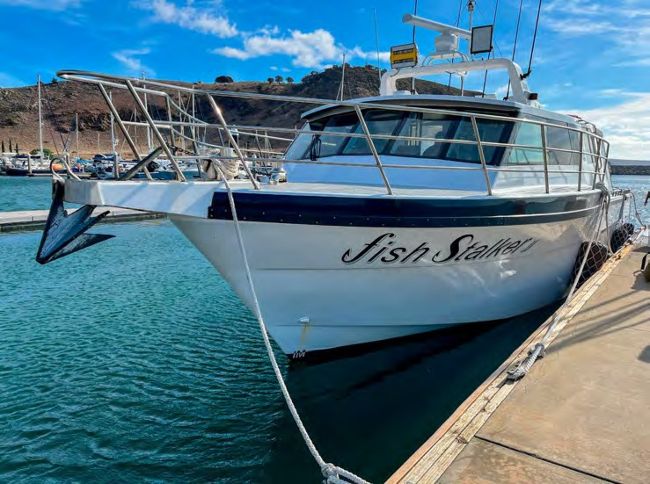
We met pre-dawn at Wirrina Cove, and after loading a mountain of tackle and food into Fish Stalker II, we threw the ropes and started steaming south. We had light winds forecast for the first morning, with strengthening south easterlies from midday onwards. Jarrod spends a lot of his charter time putting clients onto tuna around the Fleurieu south coast, so we decided to get a tuna on board early in the trip and deployed a spread of skirts and divers once wide of Tunkallila. As the sun came up we could see multiple ripple patches in the calm conditions, but as often happens with rippling tuna, they were flighty. Jarrod was confident that as the sun rose higher the fish would feed, so we persevered for an hour and eventually had a 160mm hard body eaten off the short corner. With a neat tuna of around 12kg bled and on ice, the skipper made the call to start the long steam around to the reefs wide of Cape Gantheaume, midway along Kangaroo Island’s south coast.
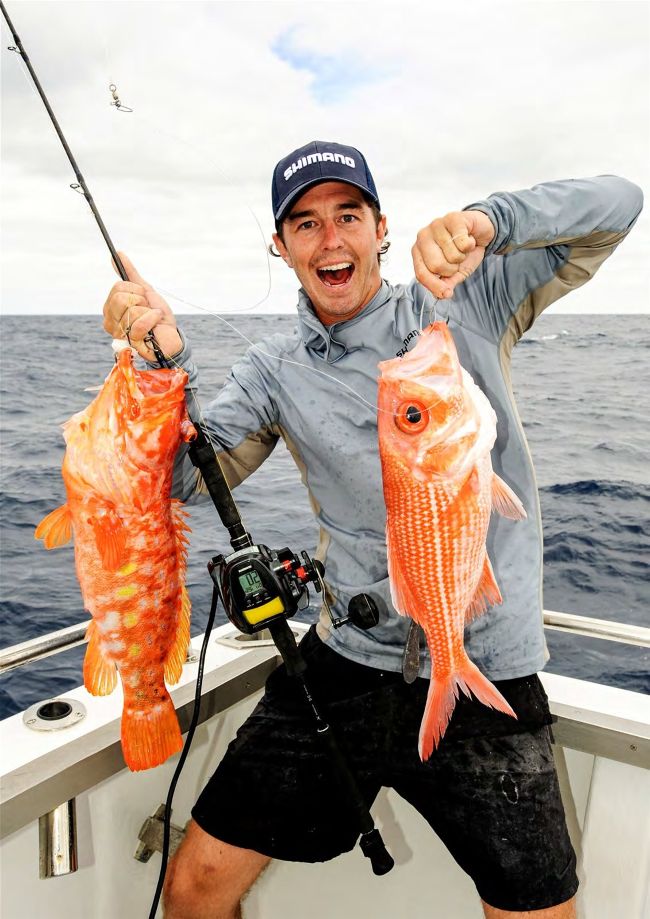
Ned McHenry with a delectable deep-water double
It was a smooth steam, which took around three hours, passing the dramatic eastern cliff faces of Cape Willoughby and Cape Hart, and eventually Jarrod eased the throttle as we started sounding over a reef which rose from 60m up to around 25m. Deckhand Tom started a berley trail of chopped pilchards while we worked 250g jigs around the tapering edge of the reef, hoping to see a kingfish or two.
Ned had arranged a stack of tackle for the trip, with new rods and reels along with lures to test on these deeper reefs. The new 250g Easy Pebble jigs were the jig of choice, and soon enough there were bent rods all around as 2-3kg trevally arrived on the scene. There was a cloud of trevally under the boat and, as the skipper said, when the trevally arrive, it’s a good sign that kingfish won’t be too far away. And he was right; within half an hour there were some bright yellow tails darting through the berley trail.
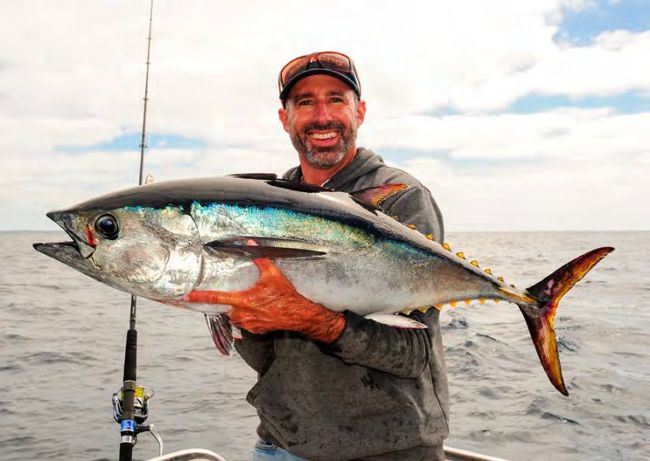
Bluefin were easy to find
We mixed up the approach with a couple of us jigging and a couple floating unweighted baits in the berley trail, and soon enough we had a couple of kingfish up to 80cm on the deck. Although not big kings, it was still good to see a couple early in the trip.
We persevered through the trevally, but with no more kingfish arriving on the scene we motored further offshore to another reef and repeated the process. Once again, the trevally were co-operative and fun, with some big trev’s keeping everyone entertained.
We spent the afternoon hopping between reefs and dropping an assortment of heavy jigs, slow pitch jigs and baits, and while we didn’t see any more kingfish action, the reef fishing was excellent. The size and number of red snapper from these reefs was incredible, and when you start releasing anything under 50cm, it’s true testament to the light fishing pressure seen in these waters.
Also mixed in with the red snapper were some pink snapper,which we could keep as we were outside of the exclusion boundary. The pink snapper were perfect table size fish at 45-55cm and we slipped a few into the ice slurry. We also got a couple of big blue groper in the afternoon, and Jamie landed a beautiful queen snapper too.
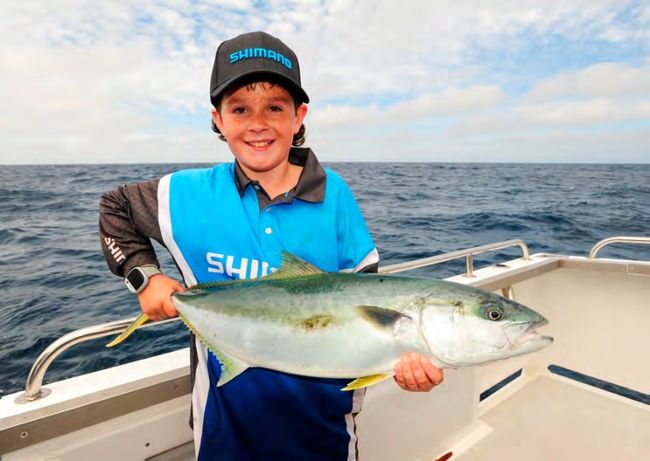
Kings don’t have to be big to be fun
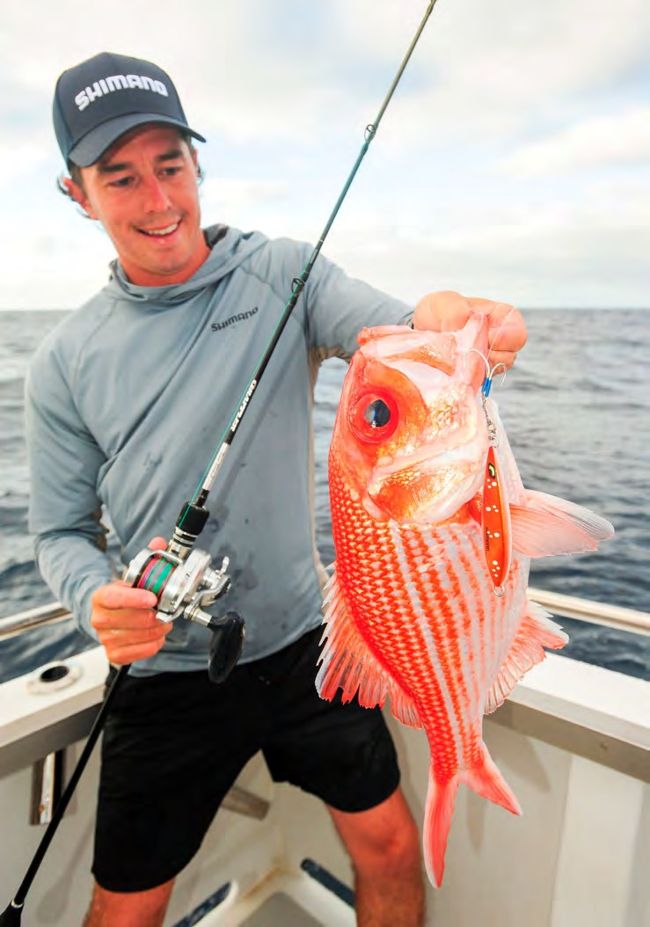
Ned with a jig-caught nannygai
Jamie was using the new Plays 3000 electric reel for most of the bottom bouncing we were doing, and he was catching some great fish using this set-up. This electric is a small model compared to traditional larger electrics, and was paired to a PE5 Type EJ Grappler rod. This combo was deadly for dropping baits around the 50-70m reefs we were fishing in the afternoon, and on a number of occasions Ned stole the combo when Jamie had his back turned. We steamed into D’Estrees Bay late in the day with a stiff sea breeze at our stern. D’Estrees is a popular overnight anchorage for the local commercial rock lobster vessels and is one of the very few sheltered anchorages along the south coast of KI. To be honest I was disappointed it wasn’t calmer when we pulled into the anchorage, with the south-easterly creating a bit of rock-and-roll once on anchor.
After a long day on the water I was starting to feel a bit green, so I sat back to take a break. Ned, on the other hand, with his youthful energy didn’t stop. He floated a fillet of trevally out under a balloon for a shark and was then cooking steak sandwiches for us. Jarrod was also busy in the kitchen, baking a couple of fresh silver trevally, which cooked up sensationally well. In my opinion, silver trevally is one of the most underrated table fish we have here in SA.
Shortly after finishing dinner, Ned’s shark reel sprang to life. We all crowded around the back deck while Ned did battle, and a nice bronze whaler came into view in the rear deck lights. Jarrod did a great job in gaffing and dispatching the 30kg bronzie, and the shark was soon trunked and iced down. Bronze whalers of this size offer really nice flake fillets, and with all on board keen to take some fish home, nothing would be wasted.
We all turned in for the night soon afterwards, and although Fish Stalker II has a forward cabin with bunks, most of us opted to sleep on the back deck in swags or on the bench seats. It was a fairly rolly night on anchor, and there were some tired eyes in the morning when the generator kicked into life at 5.30.
After a quick cuppa we were retrieving the anchor and steaming out of D’Estrees with a course to the south-west. The weather was fair on the second day, with a 10-15 knot southeasterly in the morning, which was forecast to freshen throughout the afternoon. The forecast for the following day wasn’t so promising though, with the wind predicted to strengthen to 2025 knots – far from ideal along a coastline as exposed as KI’s south coast. After a discussion it was decided this would be our last day of fishing, and we would steam back into Wirrina Cove late in the day, given the following day’s outlook.
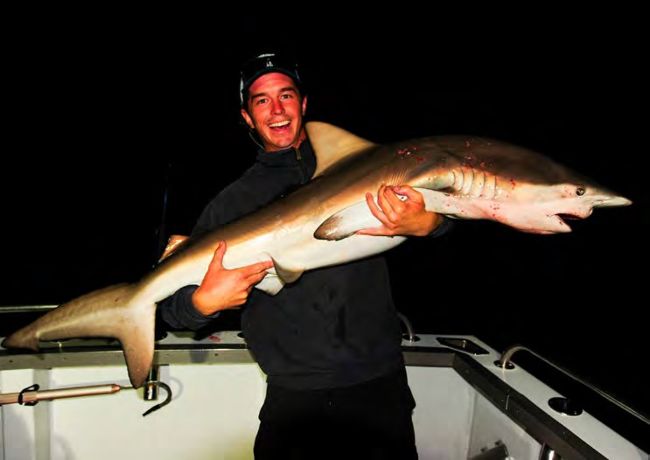
A chunky little bronzie from D’Estrees Bay
Jarrod motored us back to a reef system that we had fished the day prior, hoping to rouse a few more kingfish. On arrival, deckhand Tom started a berley trail of pilchards and on cue the trevally arrived, along with some big sweep which took up residence about 10ft under the back of the boat.
The fishing started offsteadily, with a mix of red snapper from the bottom and trevally from the upper column keeping us entertained.
Tom maintained the trail, and after a while some bluefin could be seen darting underneath the boat. This was too much of a temptation for us, which saw jigs exchanged for single 8/0 hooks as pilchards were floated down the berley trail.
It was a challenge to get baits past the trevally and sweep, but it didn’t take too long for some tuna to eat our pilchards, and it was bent rods around the back of the boat as we dodged and weaved around each other. These were fun sized fish in the 10-15kg bracket, but we saw a couple of bigger tuna of around 25-30kg in the trail that unfortunately managed to dodge our baits.
When we looked up and scanned around us, we could see multiple schools of tuna on the surface, so we decided to shelve the jigging gear and bait rods for the moment and set a spread of lures. The tuna were co-operative and great fun with double and triple hook-ups common. It was interesting to see such a big variation in fish size, with tuna as small as 2-3kg being released, along with some solid fish of 1820kg.
With the morning whittling away, we started to make our way to the east to fish some marks on our way back to Wirrina. We were all keen for some more reef fishing to put a few extra red snapper into the esky, and for Ned to get some more footage of the exceptional reef fishing in the area. We were mainly fishing with slow jigs such as 100g and 130g Wing Fall jigs and Lucanus jigs on light micro-jigging tackle, which makes this reef fishing so much fun.
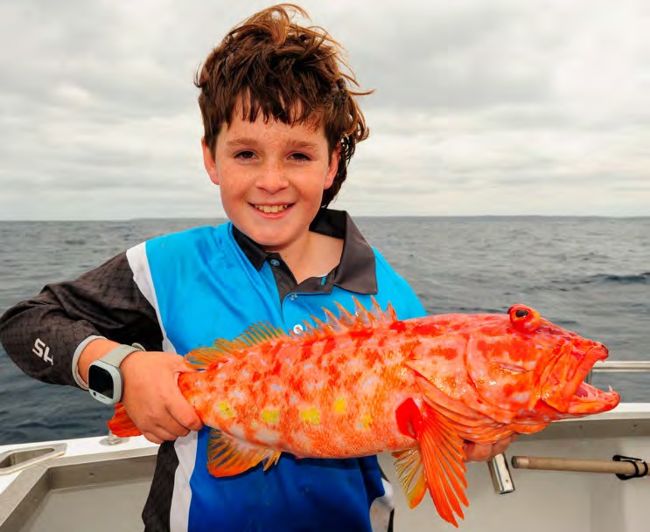
Harlequin fish are great to eat
These reefs were loaded with red snapper and a few pink snapper, and as a bonus we landed another groper and harlequin fish. With plenty of fish on ice, we stowed the rods and made the long journey back to Wirrina Cove. It was a shame the trip had been cut short due to the weather, but we had managed to target and catch a wide variety of blue water species during our two days on the water. Ned had managed to film plenty of action, so it was smiles all round.
Jarrod and Tom aboard Fish Stalker II worked hard to put us onto fish, and they ran a smooth and professional operation. If you’re keen to explore the fish rich waters of Kangaroo Islands south coast, then check them out atwww.southernfishingcharters.com.au. It had been a great few days fishing in a different part of our great state.